Puppies have a lot of hyper energy and very short attention spans.
They are also infinitely curious and want to put everything that they see in their little mouths. This can make puppy obedience training something of a challenge.
When it comes to puppy training, we want to get our puppy to repeat good behaviors, and stop bad behaviors. The more a puppy practices a behavior, the more likely she will repeat it. Therefore, by encouraging good behaviors, we ensure that she will have a good repertoire of people friendly actions to draw upon when she grows up.
Here, we deal with the 3 primary elements of puppy obedience training –
- How to communicate consistently and effectively with a puppy.
- How to encourage good puppy behaviors.
- How to discourage bad puppy behaviors.

1. How to Communicate with Puppy

The first two words I teach my puppy are “Yes” and “No”.
“Yes” is used to mark a desirable behavior and “No” is used to mark an undesirable behavior.
Yes is usually followed by a positive consequence (e.g. a food reward, affection, toys), and No is usually followed by a negative consequence (e.g. withdrawal of attention, timeout).
In fact, we do not need to use the words “Yes” and “No”, and can pick whatever mark-words we want. The best mark-words are unique, and do not frequently come up in normal conversation. This helps to prevent confusion with our dogs.
For my dogs, I use Ack-Ack as a no-mark and Good-Boy or Good-Girl as a yes-mark.
- When my puppy does something good, I say “Good-Girl” and present her with a small treat reward.
- When my puppy does something bad, I say “Ack-Ack” and redirect her into doing something positive.
Consistency is very important while communicating with our dogs. We want to stick to the same yes-mark and no-mark.
In addition, we also want to establish very consistent rules and a fixed routine. This helps our puppy understand what is expected of her, as well as what she can expect from us.


One of the first things that I do with a new puppy, is set up a fixed routine. My puppy schedule includes playing time, training time, walking time, feeding time, and the ever important sleeping time. I try to keep the schedule consistent, so that each of these activities happen at around the same time every day.
Keeping a fixed schedule is good for me, and good for Puppy. It allows me to be more efficient about getting things done, and it sets aside some me-time while Puppy is sleeping and resting in her crate.
It also helps get a puppy accustomed to a new environment, without being overly stressed. In the beginning, everything is new, foreign, and possibly scary for a new dog. A fixed schedule helps to reduce stress, increase trust, and quickly integrates her into the existing family rhythm.
Similarly, a consistent set of rules will help to avoid confusion, and hasten the puppy learning process.
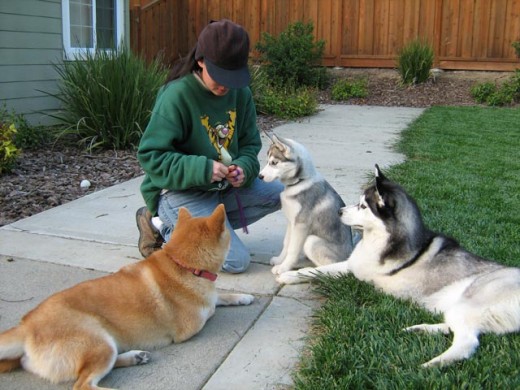
2. How to Encourage Good Behaviors
Puppy obedience training and even adult dog training is centered around two key areas-
- How to encourage and get puppy to repeat good behaviors.
- How to discourage and get puppy to stop bad behaviors.
It is important to recognize though that what we see as good and bad behaviors may not coincide with what our dog considers to be good and bad behaviors.
Dogs, even puppies, think for themselves and have needs of their own.
Therefore, we want to use our newly established communication system to teach our puppy what is good and bad for us. In addition, we must also motivate our dog so that she actually cares about our human values, which very likely, make little or no sense to her.


We encourage good behaviors by using the yes-mark, as soon as our dog finishes doing something good.
For example, when our puppy finishes doing a Sit we say “Good-Girl!” and then present her with a reward. The yes-mark is very helpful in training because it allows us to immediately mark the behavior that we want to reward.
To effectively train our puppy, we want to clearly indicate which action she is being rewarded for. If we wait too long, she will have moved on to something else, and we may inadvertently reward the wrong behavior.
Therefore, quickly use the yes-mark as soon as our dog finishes a good behavior. Then, we can take more time to present Puppy with her reward.

3. How to Stop Bad Behaviors
When it comes to stopping bad dog behaviors most of us think of applying a physical punishment, for example spanking the dog, jabbing the dog with our fingers, or giving the dog a collar correction.
These techniques apply pain to the dog, at which point the dog may stop her current behavior in order to avoid further pain and stress.
However, such pain based techniques are risky. If they are not executed with exactly the right force, timing, and redirection, they may cause more behavioral issues down the road; even aggression. It is especially risky to apply such techniques to puppies because of their young minds, and still developing bodies.
How then can we stop bad puppy behavior?

I have found that the best way to stop bad behavior is through the control of resources. *We* naturally control everything that a puppy wants, including food, toys, freedom, affection, and play.
To encourage good behaviors, we motivate our puppy by giving her something that she wants.
To discourage bad behaviors, we motivate our puppy by taking away something that she values, for example her freedom, or our attention and affection.
Note – This does not mean that we should tease our puppy and take away food while she is eating, or forcibly remove a toy that she is playing with. Doing so can encourage food aggression or resource guarding behavior.
What works best is to withhold something that my puppy wants, but does not yet have. Another possibility is to take away a privilege, such as withdrawing my attention or restricting her freedom.

When my puppy bites at my hands, I give her a no-mark (Ack-ack) and then redirect her to do something else, for example, chew on a toy. If Puppy redirects, I give her a yes-mark (Good-Girl), and reward her with something that she really wants, such as a yummy treat.
If Puppy ignores the no-mark and continues to bite at me, I withdraw my attention by standing up, folding up my arms, and turning away from her. In this way, she loses a valued play-mate, and no longer gets to engage in something fun.
If Puppy escalates her behavior and starts to jump on me or bite my clothes, I take away an even more important privilege; her freedom. I do this by calmly saying Timeout, and then taking my puppy to a boring but safe timeout area.
Puppies often bite at us to initiate play or to get our attention. We can effectively stop puppy biting by teaching her the following-
- Biting = No attention and no play,
- No biting = Attention, play, and treats.
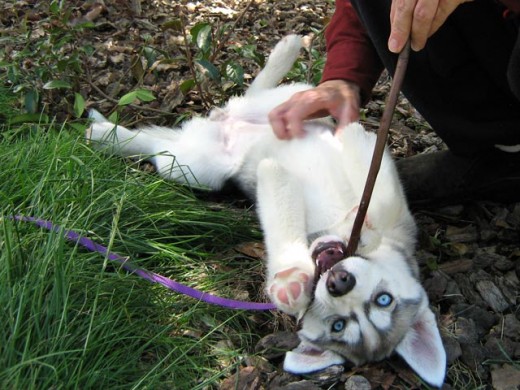
How to Train a Puppy
To stop bad behavior, I have found that it is important to –
- Start by redirecting Puppy into doing something positive. In this way, we turn a negative situation into a positive one. We not only get our dog to do what we want, but also teach her that following our commands, is the fastest way to get to her heart’s desires.
- Make the punishment suit the crime. I always start small and give my puppy many opportunities to choose a path for success. If she continues or escalates her bad behavior, then I slowly escalate her punishment.
- Stay calm at all times. Puppies have high energy and are easily distracted. If we get angry or frustrated, we will only inject more bad energy into an already volatile situation. This will likely cause our puppy to lose focus, become more hyper, and behave in an even more erratic fashion. If we want our dog to be calm, we must stay calm ourselves.
- Set Puppy up for success. Carefully manage our puppy and only expose her to situations that we think she can handle. For example, start by introducing her to new objects that are not moving, then slowly move on to moving objects, then objects that move and make noise, and so on. Start small and slowly move up to bigger things. The more successful a puppy is, the more confident she will become, and the more balanced she will be when she grows up.
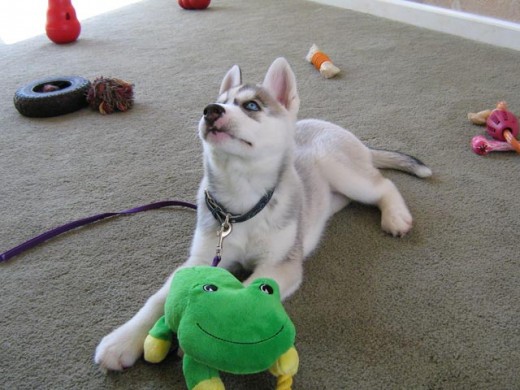
Goal of Puppy Obedience
The goal of puppy obedience is to learn how to communicate with our puppy, and teach her how to live well and harmoniously with us.
Obedience training can also help to protect our puppy from inadvertently harming herself and others, or from engaging in activities that may be detrimental to her health (e.g. over-eating, walking on glass).
Obedience training is *not* for acting out our anger, or venting our frustrations when our puppy poops on our furniture, eats poop, and spreads garbage all over our expensive designer couch.
We are not perfect, and Puppy is not perfect. In the initial stages, mistakes will be made, some of which may lead to chewed up designer shoes, scratched kitchen cabinets, and stained carpets. However, this is all part of the learning process.
Puppies, and indeed all dogs do not perform bad behaviors just to piss us off, make us angry, or exact revenge.
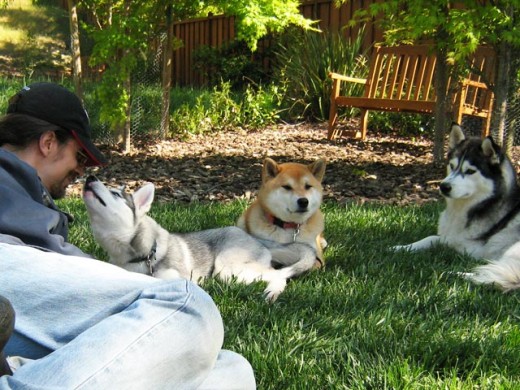
Puppies Acting Badly
Puppies or dogs act badly because …
- They do not know that something is bad because we did not teach them properly.
- They were stressed and started chewing, digging, or even pooping in order to relieve that stress (displacement behaviors).
- They felt threatened and thought it was necessary to protect themselves, or their belongings.
The key to puppy obedience training is in learning to see things from our dog’s point of view.
Once we understand what motivates our puppy, we can prevent undesirable actions and encourage desirable ones.
Dogs spend a lot of time observing us, understanding what makes us tick, and making us happy. The least that we can do, is try to return the favor.
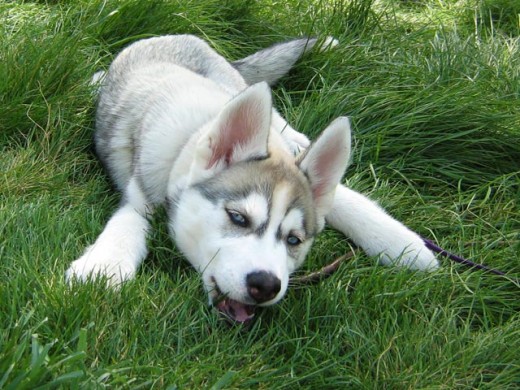
Hi I recently got a Siberian husky puppy and all he does the majority of the day is sleep is this common? He’s 9 weeks already so I’d accept him to be more active. When I try to walk him he just stays there and won’t move.
That does sound somewhat unusual for a Husky puppy.
When I get a new puppy I usually take him to the vet for a checkup as soon as possible. In this way, I can make sure that he is in good health, and I can also get him started on their recommended vaccination schedule. I do not walk my puppy outside until he is fully vaccinated. Puppies still have developing immune systems, so they may be susceptible to parvo, distemper, and more.
Where did you get your puppy from?
I have also noticed this with Butch, our Siberian. He will play and such, but he seems to nap often. He has been given a clean bill of health with the exception of fleas, which we bathed him in dawn and used puppy frontline and I haven’t seen a flea in 3 days now. I thought maybe they were getting the best of him, but the frequent napping continues. He does have another appt with out Vet on the 26th.
I have a husky puppy, and most of his training is going well. However, recently he has started becoming extremely aggressive while running. I have tried ack-ack, shaking a can of pennies, and ending the walk. He continues to bite me and the leash but only when i try and run with him. Any ideas?
http://shibashake.com/dog/siberian-husky-facts/comment-page-4#comment-101303
Hi,
I recently got a shiba inu puppy and is currently teaching him to stop biting me, but it’s not working!
He only bites/nips when he gets excited or if there is a lot of people around. How do I get him to stop this?
He tends to bite my hands when I am playing with him and when I am standing he bites at my legs.
I tried hand-feeding him and it has worked for him to have a soft mouth up until recently and he bit too hard and drew a bit of blood.
I’ll say no and walk away but he’ll bark and continue to bite!
This is what I do to train my dogs not to bite on me.
My puppy usually bites when she is excited and/or wants to interact and play with me. Therefore, I redirect her biting onto a toy, and teach her that biting on a toy leads to more fun and more play. On the other hand, biting on me leads to no interaction and no play. I also make sure to stay extremely calm, and I *do not* walk away. If I walk away in this situation, my puppy will think I am starting a game of “catch me”, and she will follow me, try to play, and get even more excited.
When Sephy was young, I used a drag-lead on him (*only* under close supervision and *only* with a flat collar) so I have better control and can properly stop him from performing bad behaviors. I also use it to lead him to timeout (if necessary) without any fuss.
Here is more on how I stop puppy biting.
Shibas can be difficult to train and handle. I visited with several professional trainers when Sephy was young, and it was very helpful.
http://www.apdt.com/pet-owners/choosing-a-trainer/
Hey. I just got a husky puppy. I want him to spend the majority of the day time outside and night time inside. When I put Loki outside all he does is cry and howl and bite at our security door. I’m afraid he’s going to break his teeth. Some people say to ignore him and some say to squirt him with water. I don’t want to do either of those as they seem to be on the nasty side. How would I go about training him not to do it?
Also how would I go about teaching him to “go to bed” when it’s sleep time and not want to play and get into everything?
Thanks =)
Congratulations on your new Husky pup!
Puppies, especially Husky puppies are very affectionate, and they like being with their family most of the time. Husky puppies are also very high energy, so they need structured activities to keep them occupied.
I train my dogs to get used to alone time by doing desensitization exercises. I start by doing only very short periods of alone time, and then I *very slowly* build up their tolerance.
When separated from their people, puppies may cry, chew, or paw at doors, because they are stressed and want to get back to their people. Because the behaviors are symptoms of stress, any kind of aversive punishment (e.g. water squirt) will *not* help and will probably make things worse.
A bit more on dog anxiety.
I also set up a fixed schedule for my puppy and a consistent set of home rules. My puppy’s schedule includes a lot of training, play time with me, supervised play time with my other dogs, and grooming exercises. Structured activities help to teach my puppy play rules and house rules, as well as gives her many positive outlets to drain her energy.
A couple of hours before bedtime, I start to slow things down and keep puppy calm. Then, I let her work on a frozen Kong before bed.
Here is an article about the first ten days with my Husky puppy, Lara. It was difficult and very tiring – but worth it in the end. 😀
Hi,
I have a 6 month old husky named Aro.
He is a well behaved dog, follows commands and is very calm ‘most’ of the time.
However, whenever he gets something he is not supposed to have such as socks, human food etc. or when he is eating his dinner or is given a new chew toy such as a pigs foot he gets uncontrollably aggressive.
I try to stop him by saying no and grabbing it out of his mouth but sometimes this is impossible. He shows his teeth, growls, and lunges towards me. I have been too fast for him to bite me although he has latched onto my shirt once.
I know the answer is to put him in his timeout zone, which eventually I do, but sometimes it is too dangerous for me to grab him to be able to put him in there.
Is there a way of getting him out of this habit and getting him out of this aggressive zone in his mind?
Thank you
Hello Sophie,
This behavior is also known as resource guarding or food aggression. Here are some things that I do with my dogs to teach them not to guard objects-
Why dogs get aggressive over food and toys.
How I teach my dogs not to be food aggressive.
Why my Shiba Inu started guarding his resources.
Hi thanks for the articles they have given me hope I have a 6 year old male siberian (Jack) and we have now got a 6 week pup ( Sasha) Jack was raised outside and Sasha is being raised inside (due to the swimmimg pool until we can teach her to swim) she lets us know when she wants to potty and whens shes hungry or thirsty but also her biting has just started as well as her magic escapism tricks(houdini) she seems to just wiggle her way out of any area weve created inside the house, she is proving to be more enegetic than Jack and doesnt respond well to the word no. I need to set boundaries for her to help her feel safe and secure because at the moment she gets too excited and then the biting begins and takes a while before it subsides. My husband does the tug of war game with her but she expects me to be as rough and when im not she gets annoyed and starts “attacking”me. I dont recall Jack being like this, she is so tiny and doesnt seem to follow commands yet not does she seem to recognise her name, any advise?
Yeah, my Husky Lara also had crazy energy and the attention span of a gnat during puppyhood, which makes training a bit more of a challenge. 😀
With Lara, consistency is very important during training. We set up a consistent set of rules, which we both enforce in the same way. For example, there is no hard-biting on people and no rough-play. If we sometimes allow rough play and sometimes not, a puppy will have a difficult time understanding what we want from her. As a result, she may keep trying to play rough, because the next time she tries, we may give in and play with her without any rules.
To make things clear and to facilitate learning, I try to be very consistent with house rules and play rules.
As for biting, I first no-mark the behavior, then, I tell my puppy what to bite on instead, for example, a toy. Sometimes, I give her an alternate pre-trained command. If she redirects, then I reward her well with a fun game and food. In this way, she learns not to bite on me, *and* she also learns what to do instead, e.g. bite on the toy. Here is more on what I do to stop my puppy from biting on me.
Here are a few more puppy biting tips that helped with Husky Lara.
I also follow the Nothing in Life is Free program with all of my dogs. It is a great way to motivate them to follow house rules, and to build trust.
With my Huskies, it is always the most difficult in the first few weeks. Then they get better, and I forget what a pain in the ass they were. 😀
Lara is now over 2 years old and she is a big sweetie, but here is a record of her first puppy days.
Big hugs to Jack and Sasha!
Hi ShibaShake my dad and brother keep on putting my 8week husky maya outside in this area where we are supposed to put her but everytime they leave her she starts to cry,whine and weep and I don’t know what to do because we recently got a trainer and he told us his opinion about where we should put her and etc. I don’t know what to do and every time she crys I feel sorry for
Hello Cindy,
Is placing her outside for potty training? What behavior/problem is the trainer trying to address?
Hello i have a 10 week old husky and his name is rocky. Now i also have a 3 year old lab-retriever named casper. I feel rocky looks up to casper alot although very differen’t personalities casper is very calm. Now when i try to train rocky he is very stubburn and if you keep repeating a command you lose his attention. Also he tends to bite us alot i hold his mouth close gently and say no and it only seems to aggrevate him more, i’ve also tried to say no and tell him “pow pow” and hell get more aggresive and want to bite more. When training his good on his training pads but doesn’t go poop on them he decides he reather go somewhere else. I was very good at training my 3 year old but i dont know how to go about training rocky to become a little bit more like my 3 year old dog. I would really appericiate some help
Here are some things that I do to control my Husky puppy’s biting –
http://shibashake.com/dog/puppy-biting-how-to-stop-puppy-biting#timeout
http://shibashake.com/dog/puppy-biting-tips-solutions
I find that any physical interaction (e.g. holding her mouth) will only get her more excited, because she thinks I am playing a fun wrestling game with her. When my puppy bites, she is usually trying to initiate play or get my attention. Therefore the best way to control her biting is to teach her that –
I also do bite inhibition training with all of my dogs to teach them to control the force of their bites when they are interacting with people.
As for commands, I first start with hand signals. I find that my puppy learns visual signals much faster than verbal commands. Once she learns the behavior and associates it with the visual signal, then I start to associate the behavior with the verbal command. In the beginning, I say the verbal command *one time* and do the visual signal at the same time. Then I wait for the right behavior from my puppy and reward her very very well for doing it. Each success will reinforce the behavior and teach her to associate the verbal with the action. Once she is doing well, I *very slowly* phase out the visual signal.
Here is a bit more on how I taught my puppy some simple commands –
http://shibashake.com/dog/puppy-biting-tips-solutions#look
I also follow the Nothing in Life is Free program with all of my dogs to motivate them to follow house rules and do work for me.
Good luck and bigs hugs to Rocky and Casper!
Hello!
First, I love your articles, they are very useful!
But, I have a question:
How can I prevent my husky from digging soooo much in my garden?
Thanks!
Haha, yeah my Sibes also love to dig. Two things helped with them –
1. No-dig training.
When Lara starts to dig in a “no-dig” area, I no-mark, and get her to do something else. If she keeps going back to digging on the unsanctioned area, I take her inside the house and she temporarily loses her outside privileges.
In the beginning, I also watch her when she is alone outside, so I that I can no-mark and correct the behavior. In this way, she learns that the no-dig areas are off-limits even when I am not around.
2. Other outlets for their digging energy.
It also helps a lot to have other outlets for their digging energy. For example, we left a big area of our backyard unlandscaped so that Lara and Shania can have fun digging there. When I take them out for walks, we often go to areas where they can have fun digging.
Instead of just suppressing the behavior, this gives them positive outlets for enjoying their need to dig. 😀